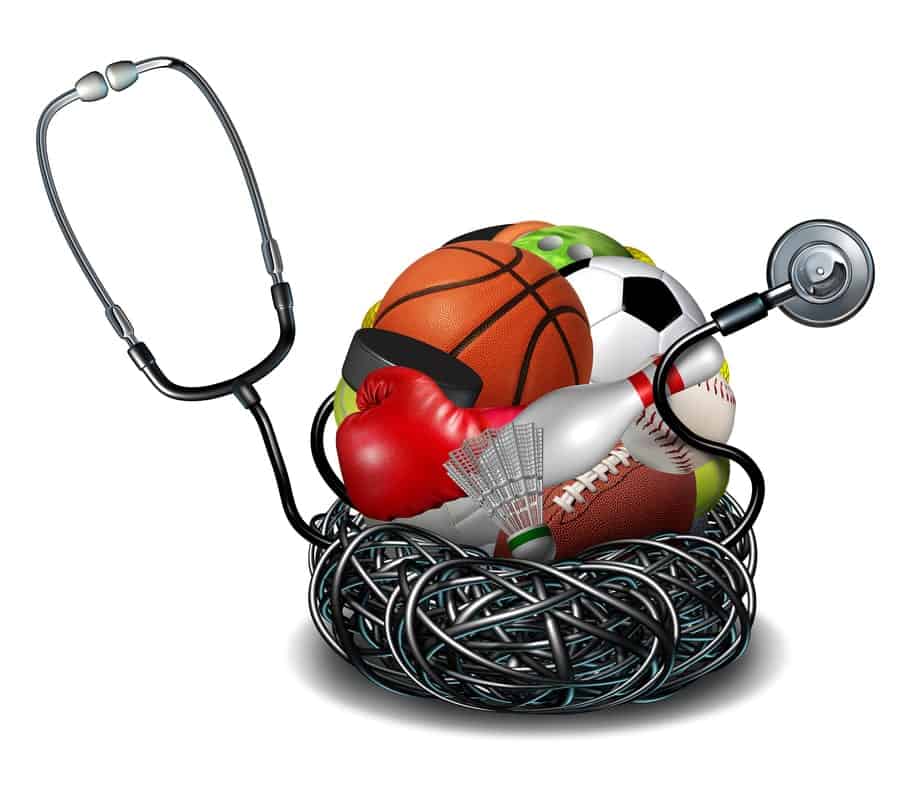Sports are frequently seen as an escape from drug use, especially in youth. People who engage in youth sports have a much lower rate of drug use, as the team atmosphere and the presence of a strong role model is usually a good way to keep people from bad influences. But we’re not talking about the benefits of team sports, good influences, and strong role models. We’re talking about the connection between sports injuries and drug addiction. At first, that connection may not be obvious, but it’s definitely there. Increasingly, athletes in any sport can fall victim to addiction for a number of reasons. And that’s not limited to just the highest level of famous athletes. This is an epidemic that affects all athletes, from world-class professionals to amateurs and even high schoolers. Of course, athletes are ultimately just regular people. They’re as susceptible to drug addiction as anyone else, and a high level of physical prowess and athleticism doesn’t make them any more resistant to addiction. Anyone can become an alcoholic or a drug addict, due to factors that may have absolutely nothing at all to do with their profession. What being an athlete does do, however, is put people at a heightened risk of exposure to drug usage. And of course, drug usage can frequently evolve into drug abuse, given time and extenuating circumstances, like stress and anxiety. But what’s the connection exactly? How do people go from playing a sport to using drugs to being addicted? There are actually a number of paths and substances people can fall into through sports, many of them geared towards improving performance or recovering from injury. Let’s first talk about one of the most harmful and common: opioids for pain relief.
What is the Link Between Prescription Opioids and Sports?
Simply put, prescription opioids are meant for relieving extreme or chronic pain. This is a role it does well, and it has certainly improved many lives in its ability to relieve pain. How this intersects with sports injuries is simple: sports involve pushing the human body to the very limits of its ability. Sometimes that means pushing the body a little too far, and that means injuries. Athletic injuries can be extremely painful and involve very long recovery times, and in many cases, a simple dose of Tylenol just won’t cut it. Prescription drugs, especially opioids, are commonly used during physical therapy and the rehabilitation process to deal with the pain of the recovery process. Oxycontin is a particularly common culprit, and there’s no doubt it does a lot of good in the pain management department. But Oxycontin is an opioid, and as such can be highly addictive. Other opioids and opioid combinations commonly prescribed include:
- codeine
- methadone
- morphine
- oxycodone
- hydrocodone
- fentanyl
- hydrocodone/acetaminophen
- hydromorphone
- meperidine
- oxycodone/acetaminophen
- oxycodone/naloxone
These can all be prescribed by trained physicians (usually under their more user-friendly market names) to fight pain, and they can all cause addiction. See, one of the most harmful misconceptions about drug abuse and addiction is that it is always the result of personal choice. That’s not the case at all. Addiction is not a choice, and in many cases, neither is the initial decision to use. Sometimes the only mistake anyone makes on the way to addiction is taking the advice and medication given to them by trusted medical professionals. According to the Substance Abuse and Mental Health Services Administration, over 22% of people who end up abusing prescription painkillers got them from a doctor. That’s in addition to the more than 50% of people whose prescription drug misuse started because they got it from friends or family members for free. That adds up to well over 72% of prescription drug abusers whose prescription drug abuse started because they got pills from someone they trusted. That does not, of course, mean that these doctors and medical professionals are bad people, or that their advice is to be ignored. It also doesn’t mean that the people who have fallen victim to addiction would have been better off ignoring their doctors or cutting off their friends. What it means is that opioids are a very powerful force with a very high rate of addiction, and that if you are prescribed them, you should be very careful to take them exactly as directed. That may still not be enough – sometimes even reducing all the risk factors of addiction as much as you possibly can isn’t enough to avoid addiction. Sometimes one regular-size use is all it takes to start an addiction. It’s important to note that this isn’t your fault. Addiction is not an issue of willpower or moral fiber. It’s a chemical reaction in your body, and it can happen to anyone. Athletes, who see a high rate of physical injury, also see a high rate of prescription painkiller use, which means they also see a high rate of drug abuse. Retired NFL players use opioid painkillers at about three times the rate of the general population. And it doesn’t just end there.
Going From Legal Opioids to Illegal Heroin
What happens with prescription opioids is that it floods the part of the brain responsible for responding to rewarding behavior. The result is a complete overload of positive feelings that block out anything negative. Simply put, opioid use makes you feel an intense happiness all over, dulling your pain and any other negative things you may feel. This feeling is what makes opioids so effective as painkillers. But the chemical reaction it sets off in your body is also what makes prescription painkillers addictive. And the problem that many prescription opioid addicts run into is that these pills are expensive, and relatively difficult to find reliably. Because of this, many of those who become addicted over the course of a prescription end up running out of pills and finding themselves unable to secure a new supply. The solution they often come to is a dangerous, but common one: heroin. The reality is, prescription painkillers and heroin share a lot of similarities, and the effect they have on the human body tends to be extremely similar. In short, they give basically the same high. So in many cases, people will get hooked on opioids through a perfectly legal prescription, then feed that addiction with heroin once the prescription ends. This is extremely common. A 2014 survey of opioid abusers showed that 94% of people used heroin because it was cheaper and easier to obtain than prescription drugs. It also turns out that 80% of new heroin users started with prescription painkillers. The tradeoff is that using heroin is much less safe. Heroin was responsible for 10,574 fatal overdoses in 2014, and roughly 25% of those who use it develop an addiction. Between 2010 and 2013, heroin overdoses increased by 37% per year. Things have gotten so bad that President Barack Obama spent a great deal of time raising opioid awareness and allotted over $1 billion in funding to fight the opioid epidemic in the final year of his presidency. And it’s impossible to separate the prescription drug epidemic from the heroin epidemic because the two are so closely related. And for athletes, whose sports injuries so often are a source for chronic pain, painkillers are much more likely to be a chronic habit. And that chronic habit often leads to addiction.
Drug Abuse and the Pressure to Perform
Sports are stressful at nearly every level. It is a unique atmosphere that places emphasis on performance over physical care. The concept of “playing through” a serious injury is glorified, even though it has a high potential to cause major health problems. This fuels a pressure in many athletes to push through minor injuries, often causing long-term damage in the process. In many cases, athletes will use painkillers to deal with the aches and pains, and this will eventually become a habit. Doctors feed into this practice, especially with young athletes, by prescribing these pills by the bottle, when just a few days’ supply would do the job. In a team atmosphere, nobody wants to be the “weak link.” Even if that “weakness” is caused by an unavoidable injury, the pressure to overcome and contribute to the team overrides any sense of self. Many coaches are learning to put the health and well-being of their players first, but the reality is that pressure comes from all angles. An athlete feels pressure from within to perform. They are often pressured by teammates, by parents, peers, fans, and most of all by themselves. The pressure turns into desperation, which leads them to take any steps necessary to perform at the level they expect. This results in much more than just opioid addiction. Sometimes injuries aren’t even involved. Often we’re just talking about doping. Many athletes feel such an intense pressure to perform that they will go to any lengths to achieve perfection. This can lead to an abuse of steroids, hormones, and “focus” drugs such as Adderall. While these drugs may not have the same chemical addictiveness that opioids do, they are all potentially harmful if abused, and all can be habit-forming. The biggest risk with these substances is that athletes become addicted because they find themselves unable to perform at the same level if they don’t use their performance-enhancing drugs. Of course, these drugs are typically banned at every level of play, but that doesn’t stop athletes from abusing them in their desire to gain an edge.
Recognizing and Treating Painkiller Addiction in Athletes
While opioids in general are dangerous, the last thing you want is to let an addiction to painkillers shift into an addiction to heroin. While either addiction is harmful and dangerous, heroin has many more pitfalls to it, and is more likely to result in an overdose and other major health issues – especially if it is used intravenously. The needle alone carries a number of health risks to it, regardless of what it’s carrying. The heroin only makes it worse, as it’s a much more direct shock to the system that bypasses all of your body’s main filtration and detoxification functions. That’s why, if you or someone you love is an athlete dealing with a painful injury, it’s important to be extra vigilant about the effects of the drugs you may be prescribed. Look for the following symptoms:
- mood swings
- social isolation
- constipation
- nausea and vomiting
- slurred speech
- itchy, flushed skin
- depression
- tolerance (need more of the drug for the same feeling)
- seizures
Any of these could be signs of a serious addiction that needs to be addressed immediately. If you find yourself visiting multiple doctors to try to get a new prescription, consider getting some help before the situation gets worse. Of course, dealing with chronic pain is a difficult situation no matter how you go at it. It may seem preferable to deal with the pain of addiction rather than the pain of your physical ailments. But it isn’t the answer. There are ways to manage your physical pain that won’t take control of your life and drive it into the ground. Painkillers aren’t one of them. For starters, you will eventually build up a tolerance. No matter how good the painkillers make you feel, they’ll eventually stop working as your body adjusts. To get the same feeling, you’ll eventually have to use more and more and more, until either you can no longer afford it or your body can’t take any more. Both of those paths lead to ruin. If you suspect you or a loved one is suffering from a prescription painkiller addiction, whether it’s related to sports or not, contact us immediately. The best option is to get started on a plan to deal with your addiction and your physical pain through holistic, evidence-based treatment. Do you assume you have to choose a tradeoff between the pain of injury and the pain of addiction? Because you don’t. There is another way.


